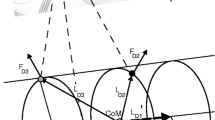Summary
Two monkeys (Macaca fascicularis) were trained to perform fast conditioned fingergrip on a small transducer. When performance was stabilized to the shortest possible reaction time, the pyramidal tract was transected on one side in one monkey, bilaterally in another. Retraining was resumed 1–3 weeks after surgery. Response latency as well as electromyographic latency and summation time were measured before and up to several months after pyramidotomy.
The data show that pyramidotomy induced a long-lasting slowing in the performance of the fingergrip. This slowing was due mainly to a delay in the execution of the movement. However, a short-lasting significant delay of the onset of the EMG activity preceding the movement shows that not only the execution but also the initiation contributes to the increase of the mean response latency. The deficits were more severe and of longer duration in the monkey with bilateral pyramidotomy, especially the delay in the onset of the EMG activity. The mechanisms underlying these deficits and the role of the pyramidal tract in rapid movements are discussed, specifically in consideration of the possible function of the ipsilateral pyramidal tract.
Similar content being viewed by others
References
Beck, C.H., Chambers, W.W.: Speed, accuracy and strength of forelimb movement after unilateral pyramidotomy in rhesus monkeys. J. comp. physiol. Psychol. 70, Monograph No. 2, Pt. 2, 1–22 (1970)
Brinkman, J., Kuypers, H.G.J.M.: Split-brain monkeys: cerebral control of ipsilateral and contralateral arm, hand and finger movements. Science 176, 536–539 (1972)
Brinkman, J., Kuypers, H.G.J.M.: Cerebral control of contralateral and ipsilateral arm, hand and finger movements in the split-brain Rhesus monkey. Brain 96, 653–674 (1973)
Clough, J.F.M., Kernell, D., Phillipps, C.G.: The distribution of monosynaptic excitation from the pyramidal tract and from primary spindle afferents to motoneurones of the baboon's hand and forearm. J. Physiol. (Lond.) 198, 145–166 (1968)
Hepp-Reymond, M.-C., Wiesendanger, M.: Unilateral pyramidotomy in monkeys: effect on force and speed of a conditioned precision grip. Brain Res. 36, 117–131 (1972)
Kuypers, H.G.J.M.: Central cortical projections to the motor and somatosensory cell group. Brain 83, 161–188 (1960)
Kuypers, H.G.J.M., Brinkman, J.: Precentral projections to different parts of the spinal intermediate zone in the rhesus monkey. Brain Res. 24, 29–48 (1970)
Laursen, A.M., Wiesendanger, M.: The effect of pyramidal lesions on response latency in cats. Brain Res. 5, 207–220 (1967)
Lawrence, D.G., Kuypers, H.G.J.M.: The functional organization of the motor system in the monkey.I. The effects of bilateral pyramidal lesions. Brain 91, 1–14 (1968)
Liu, C.N., Chambers, W.V.: An experimental study of the corticospinal system in the monkey (Macaca mulatta). J. comp. Neurol. 123, 257–283 (1964)
Miller, J.M., Glickstein, M., Stebbins, W.C.: Reduction of response latency in monkeys by a procedure of differential reinforcement. Psychonomic Science 5, 177–178 (1966)
Napier, J.: The evolution of the hand. Sci. Amer. 207, 56–62 (1962)
Preston, J.B., Shende, M.C., Uemura, K.: The motor cortex-pyramidal system: patterns of facilitation and inhibition on motoneurons innervating limb musculature of cat and baboon and their possible adaptative significance. In: Neurophysiological basis of normal and abnormal motor activities. Ed. by M.D. Yahr and D.P. Purpura, pp. 61–74. Raven Press 1967
Phillips, C.G.: Evolution of the corticospinal tract in primates with special reference to the hand. Proc. 3rd int. Congr. Primat., Zürich 1970. pp. 2–23. Basel: Karger 1971
Tower, S.: Pyramid lesions in the monkey. Brain 63, 36–90 (1940)
Author information
Authors and Affiliations
Rights and permissions
About this article
Cite this article
Hepp-Reymond, M.C., Trouche, E. & Wiesendanger, M. Effects of unilateral and bilateral pyramidotomy on a conditioned rapid precision grip in monkeys (Macaca fascicularis). Exp Brain Res 21, 519–527 (1974). https://doi.org/10.1007/BF00237170
Received:
Issue Date:
DOI: https://doi.org/10.1007/BF00237170




